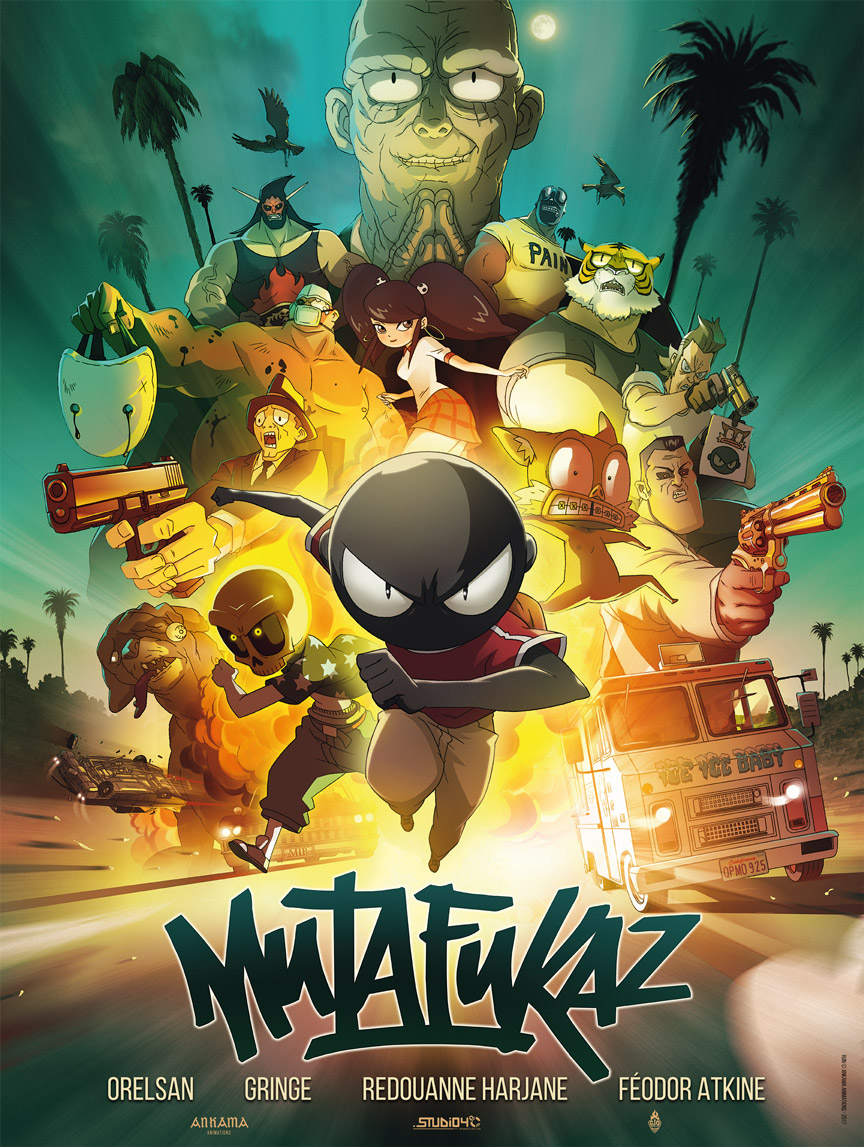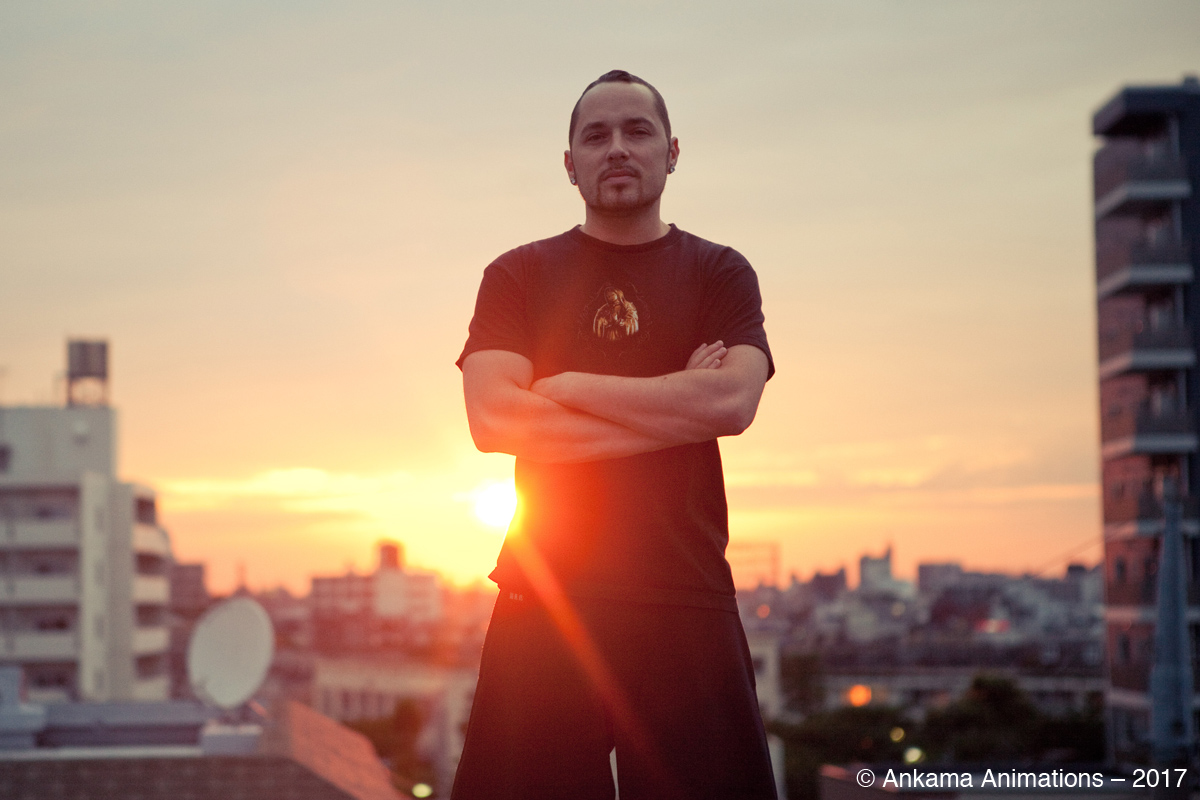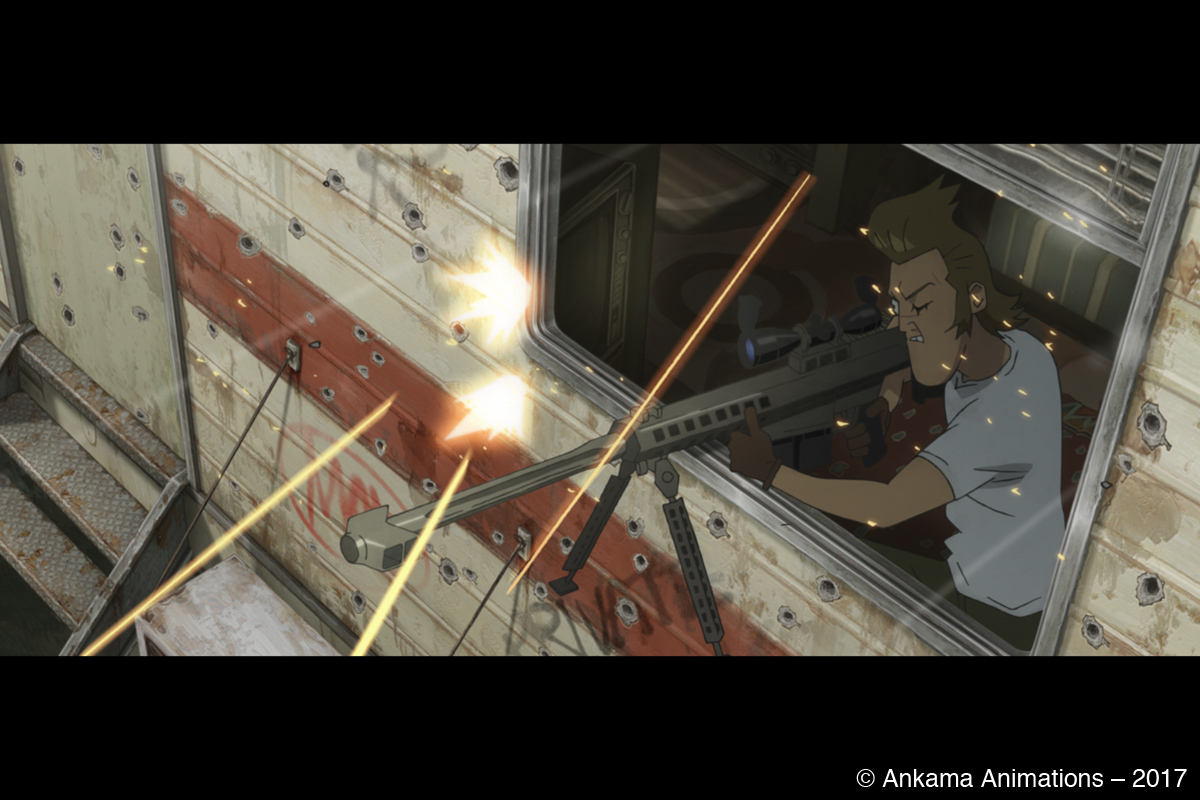Synopsis
Angelino is just one of the thousands of deadbeats living in Dark Meat City, a ruthless megalopolis in sunny California. At day, he runs the streets of the city delivering pizzas; at night, he squats a seedy hotel room with his homie Vinz and an army of cockroaches that are now part of the family.
Following a scooter accident caused by the heavenly vision of Luna, a girl with jet-black hair, the young man starts experiencing violent headaches doubled with strange hallucinations. Hallucinations? Maybe not … Chased by men in black suits, Angelino has no doubts: he is a target. Why him? Following a terrifying manhunt, he is finally captured and learns the truth about his origins: he is half human and half Macho, a creature from the dark matter of the universe.
Will he join the ranks of those who secretly exploit the world’s resources … or choose another path?
Mutafukaz, an animated feature film based on a popular French comic series of the same name written by Guillaume Renard (also known as “RUN”), had its world premiere in Annecy, France on 13th June during the Annecy International Animated Film Festival 2017.
Mutafukaz is a film with a hard-core, high-adrenaline adventure for young adults and adults. Its good, tightly-plotted sci-fi story with its many dynamic action scenes encircles the unique universe enriched with the high-quality detailed background art.
Mutafukaz was co-produced by French company Ankama Animation and Japanese studio STUDIO4°C. Ankama is a French entertainment company consisting of Ankama Games, one of the leading game companies in France, which has very popular titles like Dofus and Wakfu, a comic publisher Ankama Éditions, and an animation studio Ankama Animations. STUDIO4°C is a prestigious Japanese animation studio which is well known globally for their high-quality feature films such as Mind Game (2004) and Tekkonkinkreet (2006).
Part 1: Interview with the producer Anthony Roux
We could have exclusive interviews with three key personnel of the film project, Anothony Roux, the producer, Guillaume “RUN” Renard, director, and Shojiro Nishimi, co-director. We are honored to deliver their special interviews in two parts. With this first part, we are happy to share the words of Anthony Roux, the producer of the film Mutafukaz and also one of the founders of Ankama. He talks about how the project started and teamed up with STUDIO4°C.
Animationweek (AW): How did this project start?
Anthony Roux: We started thinking about the Mutafukaz film project around seven or eight years ago, but RUN has been developing this universe through the comic books for about fifteen years. Mutafukaz made an impression with its first paper publication, thanks to its groundbreaking graphics and highly “audiovisual” narration. It is one of the flagship universes of the company Ankama, and its qualities made it an ideal candidate to be turned into a full-length feature film.
AW: Why and how did you decide to work with STUDIO4°C? What kind of benefits and strengths did you find through this collaboration?
Anthony Roux: When we started discussing adapting Mutafukaz into a film with RUN, we instantly had STUDIO4°C in mind. In fact, we didn’t even have a plan B. I met Mrs. Tanaka*1 several times in order to present the project to her and, finally, it was the universe that convinced her artists. Being great fans of Mr. Nishimi*2 and Mr. Kimura*3, we absolutely wanted to work with them. Mrs. Tanaka made this possible, and now, we are especially proud of the work done by these two incredible artists.
*1 The founder and the president of STUDIO4°C, Eiko Tanaka.
*2 The co-director and lead animator of Mutafukaz, Shojiro Nishimi.
*3 The artistic director (art board and background art direction) of Mutafukaz, Shinji Kimura.
AW: What is your favorite part of the film?
Anthony Roux: Hmm… I like many scenes from the film, but one of them in particular makes me shiver. It’s the race on the motorway where Angelino gives it his all while driving an ice cream truck. The music, the rhythm, and all the little touches of humor hidden within the action make this sequence a unique experience; it’s worth watching the film, even if it’s just for this scene.
Part 2: Guillaume Renard & Shojiro Nishimi
Here are our two special long interviews with Guillaume “RUN” Renard and Shojiro Nishimi, which uncovers the story behind the film Mutafukaz and make you deep-dive into the Mutafukaz world. RUN is the author of the original comic series Mutafukaz, which has sold over 135,000 copies, and is also the director of the film Mutafukaz. Shojiro Nishimi is the co-director and the lead animator. He is a famous Japanese animator and director known for spectacular action scenes he has created. One of his world renowned works is the character design and animation direction of a STUDIO4°C’s film Tekkonkinkreet (2006).
Interview with the director and author Guillaume Renard
AW: Why and how did you decide to adapt your comic to an animated feature?
Guillaume Renard: I’ve always loved animation, and in 2003, long before the comic books, I’ve created a short film called Operation Blackhead, which laid the groundwork for the Mutafukaz universe. So, when the opportunity to create a full-length feature film with a cult animation studio presented itself several years later, I didn’t hesitate. Anthony met Mrs. Tanaka from STUDIO4°C, and he presented a few of our comic book projects to her. Anthony has always been open to cross-media experiences, and it just so happens that Mutafukaz was what was closest to the studio’s DNA. A few weeks later, we all gathered around a table to discuss the feasibility of the project to adapt Mutafukaz. STUDIO4°C was already a guarantee of quality, so I knew that the project was in good hands.
AW: Is this your first time directing an animation? How was the experience of directing animation?
Guillaume Renard: I left the directing to Nishimi San. He was the top guy in the field. Most of all, my role was to respect the universe, the scenery and the characters’ personalities. I also had to find a few production ideas that would work with the script I had written. I did some very basic work on a storyboard. Strictly speaking, the animation part was down to Nishimi San. Then, I threw myself into the post-production, where Nishimi San gave me a certain leeway: the sound design, the music and the various graphical additions.
AW: Where did the story, characters, and universe of Mutafukaz originally come from?
Guillaume Renard: It’s a very long story. I wrote my first Mutafukaz comic strip in 1997. At the time, it was already about creating a universe that resembled everything I liked – even diametrically opposite things – while remaining consistent and relevant: film noir, 1950’s science fiction, Lucha Libre, Hip-Hop and gang culture. Over the course of the years, the universe became more refined, and everything became clearer to me. Mutafukaz is a mass of pop culture mixed in a gigantic cocktail shaker.
AW: How did you adapt your story of the original comic series to the story for the film?
Guillaume Renard: It’s a question of focussing 600 pages of the comic book into a film that’s an hour and a half long. It’s not easy. In comic books, there are many situations with many offshoots, and a huge number of characters are dealt with. For the film, I decided to concentrate on the backbone of the main story so that everything flowed and was accessible, despite the prolific universe. What story does the Mutafukaz comic tell if you remove all of the outer layers? A story about three loser friends faced with adversity. That’s what the film’s about. You can find many scenes from the comic in the film, of course, but also reinterpretations of certain parts and a rearranged environment. In the end, the comic books and the film complement each other and coexist perfectly. And one important thing: you don’t need to have read or seen one to understand the other. The two media each stand on their own two feet.
AW: This film was co-produced with a Japanese studio STUDIO4°C. How did the two production teams get together to work?
Guillaume Renard: The main part of the production was done at STUDIO4°C. There was a lot of work involving pre-production, many exchanges, and diverse references, so that Nishimi San was completely immersed in the universe (most of the references were completely foreign to him). It was a big challenge, but it was also very informative. I learned a tremendous amount alongside them. They’re people who are open, intelligent and curious about new visual experiences. I went to Japan several times throughout the year for an overall review of the situation with Nishimi San and the team leaders. Besides that, we had meetings over Skype, and validation was done over the internet. Once the images were completed, I tackled the post-production head on. The sound is just as important as the image.
AW: Could you please let us know your favourite character and scene in the film and why?
Guillaume Renard: I’m very fond of all of the characters in the film – even the worst ones. My favourite scene is still the motorway chase, because it’s fun, dramatic, and the music carries us along with the characters towards this crazy, headlong rush. But one scene from the film really moves me: when Luna holds Angelino’s hand, I feel all of the trauma from his childhood. And also the final shot, which I find both dramatic and poetic (one of STUDIO4°C ‘s trademarks).
AW: Could you please tell us about music? How did you design the music and how did you communicate with the composer to share your image?
Guillaume Renard: There was some very organic directing. I knew exactly what type of score I wanted. The universe is highly mixed, and I also wanted that to be shown visually, through a few touches of film noir music, in a very modern continuum. To do so, I called on two composers who didn’t know each other: the Toxic Avenger, from the French electro scene, and Guillaume Houzé, with a more classic approach in terms of cinematography. I wanted them both to work together in order to mix their universes. I directed them with a few key words in order to inject some positive energy each time, and as they both work on instincts, there was a good dynamic. We recorded one part of the music with an orchestra in Paris. I’m really pleased with the film’s score.
AW: What message or experience did you want to deliver to the audience through this film?
Guillaume Renard: By way of this film about friendship, firmly focussed on action, I ask questions about the different fears of the modern world: terrorism, ecological threats, the worrying rise of conspiracy theories and the motivation towards radicalisation of young people who have become disillusioned. Each person will find their own answers.
Interview with the co-director Shojiro Nishimi
AW: How was the communication with Guillaume Renard and the French team through this project as the co-director and lead animator?
Shojiro Nishimi: We had wide creative freedom on how we describe and direct the animation. So, we didn’t need to discuss much about the direction. However, we Japanese creators do not have very good ideas about the cultures outside of Japan and we asked a lot about cultural aspects of the USA and France. There are some manners, customs, and climate of the region, which is very different from those of Japan, and we needed their advice. The level of censorship and what’s ok or not are different from country to country. So, it was really helpful that we could always talk with them about the cultural side of the story.
AW: How did you develop the visuals of the film?
Shojiro Nishimi: RUN [Guillaume Renard] San had so much passion and attachment to the film, and his level of expectation was very high. So it was our challenge to develop the visuals that could meet the expectation. Also, the color design of Lino and Makabe were a bit unusual in Japanese animation production, so we had to go the uncharted road to decide the direction.
We felt closely RUN San’s big love for the film, and so we tried our best to respond to it and proposed the best we could do. I remember that I was very passionate about the character development. I also tried not to be pulled too much by the descriptive style of the bande dessinée series and make sure to pursue the uniqueness of animation.
AW: Were there any differences or difficulties in directing and animating, compared to a 100% Japanese project you have worked for?
Shojiro Nishimi: I didn’t have to think of this as a French-Japanese co-production and I could work on the production just like in creating a Japanese animated film, as Ankama trusted us to create most of the scenes. I’m actually not so familiar with production flow and style outside of Japan, so instead, I focused more on making the best use of what I know as a Japanese animation creator.
AW: As the lead animator, could you please let us know if you have anything you considered carefully in particular through the film?
Shojiro Nishimi: What I kept in mind through the whole production was to make this one good entertaining film. I wanted to make the film as amusing as possible, not only in the animation aspect but also the direction. I could not know how other people would think about the film, so I made up my mind to create, at the very least, what I could truly be satisfied with.
AW: Could you please let us know your favourite scene in the film as the lead animator?
Shojiro Nishimi: My favourite scene is when Lino and Vinz escape from pursuit and end up in the Mexican cuisine. This is when Lino realizes Luna’s betrayal and becomes awakened. This scene is a turning point and various facts get revealed from here. This one scene also contains many elements, such as Lino’s complex emotions, Luna’s betrayal and the awakened Lino’s actions. His awakening has a cathartic effect, in a way.
I also think the direction went very well with the scene where Lino, Vinz, and Willy are chased by the Crocodiles in the alley. In this scene, you can see comical sequences in a critical situation, and the tension and relief are in harmony.
AW: What message or experience did you want to deliver to the audience through this film?
Shojiro Nishimi: The message delivered by the story is RUN San’s, so I wanted to give the great experience to audience. To do that, I tried to create entertaining images and decided not to make any compromises in the direction nor the animation. My goal was to create a film that the audience would say “That was great!” after watching it. All hard work will be rewarded if audiences feel something from this movie. It was my great pleasure to work on the film with RUN San and the French team, and I hope it will be a great entertainment for everyone.
















